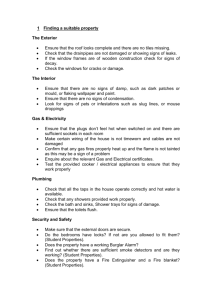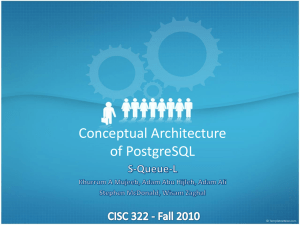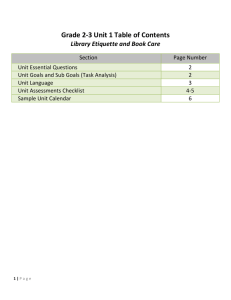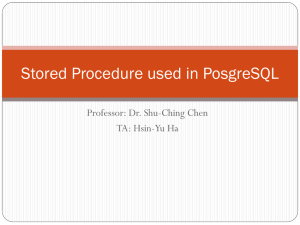Recovering From A Damaged PostgreSQL Cluster
advertisement
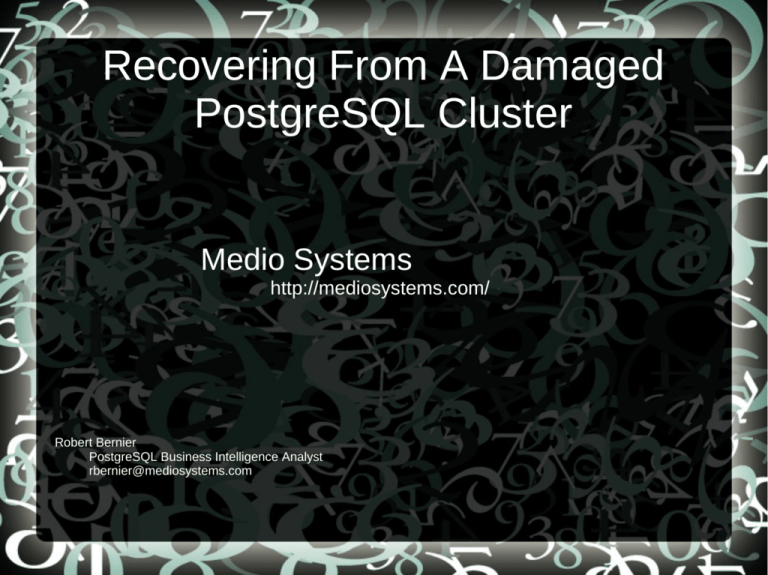
Recovering From A Damaged
PostgreSQL Cluster
Medio Systems
http://mediosystems.com/
Robert Bernier
PostgreSQL Business Intelligence Analyst
rbernier@mediosystems.com
Recovering From A Damaged
PostgreSQL Cluster
@ me
Recovering From A Damaged
PostgreSQL Cluster
Recovering From A Damaged
PostgreSQL Cluster
Recovering From A Damaged
PostgreSQL Cluster
Recovering From A Damaged
PostgreSQL Cluster
Recovering From A Damaged
PostgreSQL Cluster
Recovering From A Damaged
PostgreSQL Cluster
Just a little bit of
knowledge
Recovering From A Damaged
PostgreSQL Cluster
The secret is...
Recovering From A Damaged
PostgreSQL Cluster
Indexes & Tables are FILES!
Recovering From A Damaged
PostgreSQL Cluster
create table t1 (id serial primary key,x real);
insert into t1 (x) select random() from generate_series(1,1000);
\dtis+
List of relations
Schema |
Name
|
Type
| Owner
| Table |
Size
| Description
--------+-----------+----------+----------+-------+------------+------------public | t1
| table
| postgres |
| 40 kB
|
public | t1_id_seq | sequence | postgres |
| 8192 bytes |
public | t1_pkey
| index
| postgres | t1
| 40 kB
|
select relname,relfilenode,relpages,relpages*1024*8 bytes from pg_class where relname in ('t1','t1_id_seq','t1_pkey');
relname | relfilenode | relpages | bytes
-----------+-------------+----------+------t1
|
24628 |
5 | 40960
t1_id_seq |
24626 |
1 | 8192
t1_pkey
|
24632 |
5 | 40960
=========================================================================
cd ~/data
ls -l `find ./|grep 24628` ---> -rw------- 1 rbernier rbernier 40960 2011-03-07
-rw------- 1 rbernier rbernier 24576 2011-03-07
ls -l `find ./|grep 24626` ---> -rw------- 1 rbernier rbernier 8192 2011-03-07
ls -l `find ./|grep 24632` ---> -rw------- 1 rbernier rbernier 40960 2011-03-07
=========================================================================
11:53
11:51
11:53
11:53
./base/11564/24628
./base/11564/24628_fsm
./base/11564/24626
./base/11564/24632
Recovering From A Damaged
PostgreSQL Cluster
Damaged files cannot be processed
====================================================
-- damage the sequence, can't insert records
rm ./base/11564/24626
touch ./base/11564/24626
----------------------------insert into t1(x) values(9990);
ERROR: could not read block 0 of relation base/11564/24626: read only 0 of 8192 bytes
====================================================
-- damage the index, can't perform a query
rm ./base/11564/24632
touch ./base/11564/24632
----------------------------explain select * from t1 where id=100;
QUERY PLAN
-----------------------------------------------------------------Index Scan using t1_pkey on t1 (cost=0.00..8.27 rows=1 width=8)
Index Cond: (id = 100)
postgres=# select * from t1 where id=100;
ERROR: could not read block 0 of relation base/11564/24632: read only 0 of 8192 bytes
====================================================
-- damage the table, can't perform any query
select * from t1;
ERROR: invalid page header in block 0 of relation base/11564/24628
Recovering From A Damaged
PostgreSQL Cluster
summary invocations
--------------------Scenario: PostgreSQL Fails To Start And Reports Damage To System Indexes
Solution: generate a data-dump into a newly created data cluster
- start up the damaged cluster with the following invocation
pg_ctl -D ~/data -o '-c ignore_system_indexes=true' -l logfile.txt start
- execute standard data dump with pg_dumpall
--------------------Scenario: PostgreSQL Starts Up But Queries To User-Defined Tables Fails
Solution: generate a data-dump into a newly created data cluster
- start up the damaged cluster with the following invocation
pg_ctl -D ~/data -o '-c zero_damaged_pages=true' -l logfile.txt start
- execute standard data dump with pg_dumpall
--------------------Scenario: Rebuild And Reusing An Existing Data Cluster With Corrupted User-Defined Tables
Solution: under multi-user mode
- start up the damaged cluster with the following invocation
pg_ctl -D ~/data -o '-c zero_damaged_pages=true' -l logfile.txt start
- login the database and execute the following SQL statement
VACUUM FULL ANALYZE;
REINDEX DATABASE mydatabase;
--------------------Scenario: Rebuild Existing Data Cluster, Corrupted System Indexes
Solution: under single-user mode
- start up the damaged cluster and reindex with the following invocation
postgres --single postgres -D ~/data <<_eof_
reindex system mydatabase
_eof_
Recovering From A Damaged
PostgreSQL Cluster
Caveats
●
DROP and CREATE damaged indexes
●
Where possible, recreate the cluster on another machine... don't take a chance
●
Executing a dump should be the first action i.e. don't VACUUM damaged tables
as you can actually lose data before you reuse/backup/dump
●
Damaged system catalogs must be recovered in single user mode
●
TOASTED tables add an entirely new level of complexity
Recovering From A Damaged
PostgreSQL Cluster
References
- http://www.postgresql.org/docs/8.4/static/index.html
- http://www.postgresql.org/docs/8.4/static/app-initdb.html
- http://www.postgresql.org/docs/8.4/static/app-pg-ctl.html
- http://www.postgresql.org/docs/8.4/static/catalog-pg-class.html
- http://www.postgresql.org/docs/8.4/static/runtime-config-developer.html
- http://www.postgresql.org/docs/8.4/static/sql-createindex.html
- http://www.postgresql.org/docs/8.4/static/sql-dropindex.html
- http://www.postgresql.org/docs/8.4/static/sql-reindex.html
- http://www.postgresql.org/docs/8.4/static/sql-vacuum.html
- http://linux.die.net/man/1/find
- http://linux.die.net/man/1/killall
